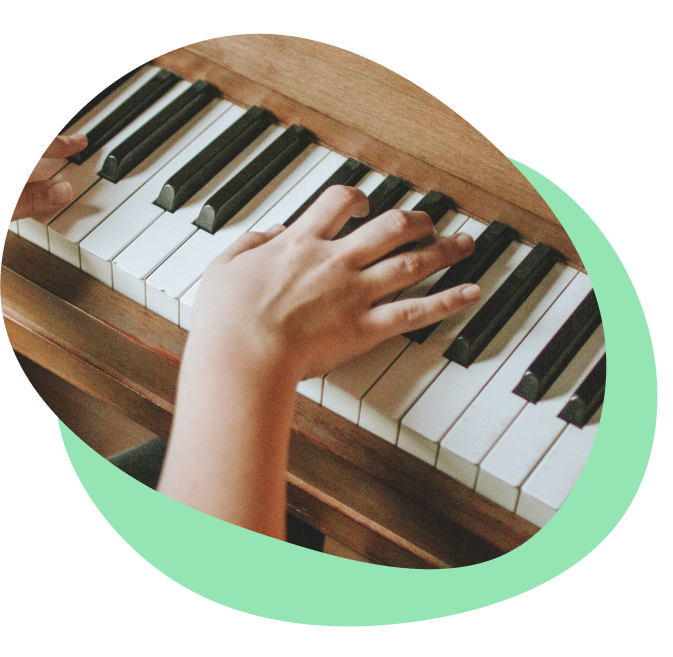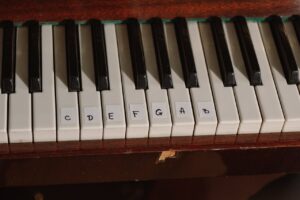The A sharp major chord is one of those chords that stands out in a song, giving it a bit of flair and drama. Learning A# major will get you out of the usual chord progressions. At Skoove, we’re here to guide you through every chord, helping you understand its role in music and how to add it to your playing.
To play the A# major piano chord, you’ll need three notes: A#, D, and F. begin by locating the note A#, which is the right most of the three black keys. Once you’ve found it, combine A# with Cx (double sharp) and E# to create the A# major triad. Play them together, and you’ll hear how the A-sharp major chord brings a fresh, powerful sound to your playing.
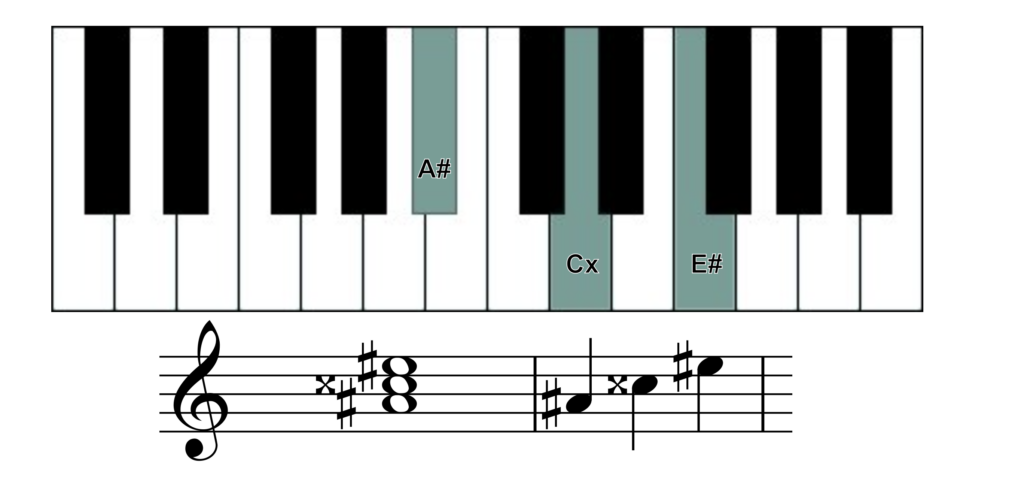
The A# major chord notes
The A# major piano chord consists of three notes A#, Cx and E#. These three notes create the major triad, a chord with a distinct happy sound.
To play this chord in its root position (basic form) with your right hand, use these fingers:
- E# – Fifth finger (5)
- Cx – Third finger (3)
- A# – Thumb (1)
For the left hand, use the following fingers:
- E# – Thumb (1)
- Cx – Third finger (3)
- A# – Fifth finger (5)
The inversions of A# major chord
Chord inversions allow you to achieve different harmonic textures and smoother movement between chords. The inversions of the A# major piano chord are created by reordering the notes within the chord.
The A# major piano chord has two inversions:
- First Inversion: This inversion moves A# to the top, placing Cx as the lowest note.
- Second Inversion: This inversion shifts both A# and Cx to the top, making E# the lowest note.
How to play A# major chord first inversion?
To play the first inversion of the A# major piano chord, begin with Cx as the lowest note. Next, play E# above it, and finally, put the A# on top. This produces a distinct voicing, which can be important for smooth chord changes.
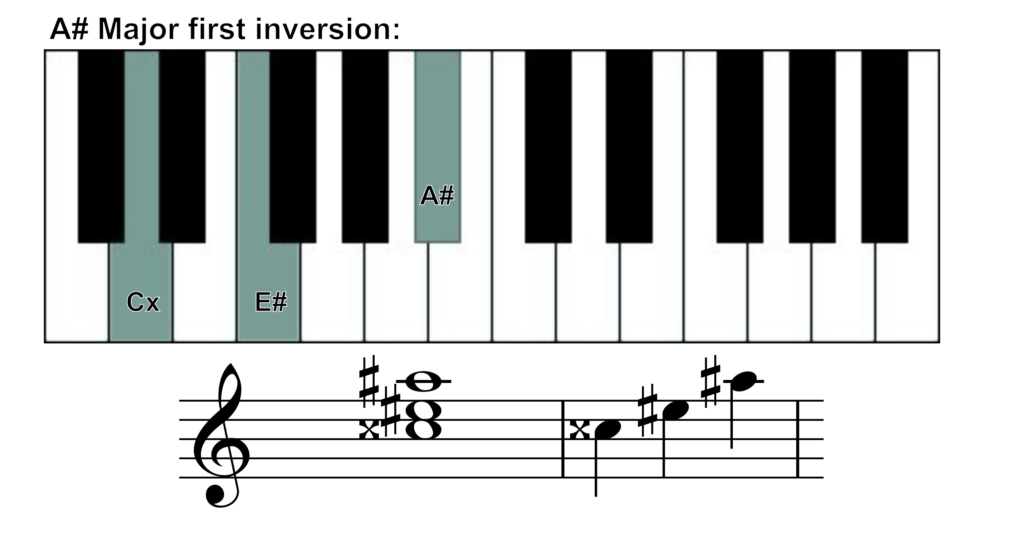
For the right hand, use these fingers:
- A# – Fifth finger (5)
- E# – Second finger (2)
- Cx – Thumb (1)
For the left hand, use these fingers:
- A# – Thumb (1)
- E# – Third finger (3)
- Cx – Fifth finger (5)
How to play A# major chord second inversion?
To play the second inversion of the A# major piano chord, begin with the lowest note, E#. Then, play A# above it, followed by Cx at the top. This variant gives the chord a fresh feel and makes it simpler to easily transition between chords and set up resolutions.
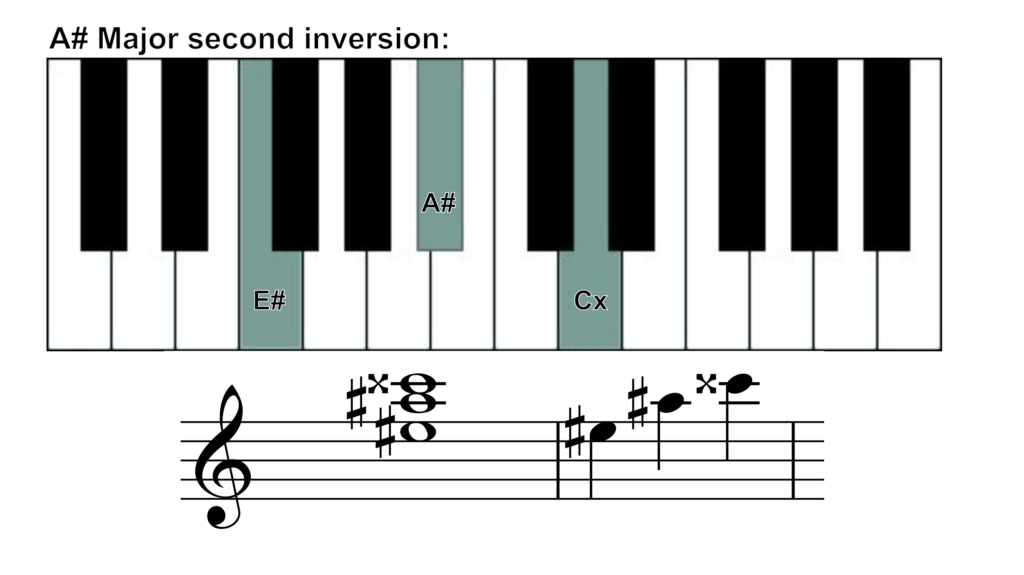
For the right hand, use these fingers:
- Cx – Fifth finger (5)
- A# – Middle finger (3)
- E# – Thumb (1)
For the left hand, use these fingers:
- Cx – Thumb (1)
- A# – Third finger (3)
- E# – Fifth finger (5)
A# major chord progression
The A# major chord progression appears in a variety of musical genres, ranging from pop and rock to jazz and classical. These progressions help create dynamic movement and emotional depth in songs. An A# chord progression often includes chords like A#, D#, E# and Fxm.
Here are some popular A# major piano chord progressions:
- Fxm – A# – D# – E#
- A# – D# – E# – E#
- A# – D# – A# – E#
- D# – E# – D# – A#
Playing these chord patterns regularly will improve your familiarity with A# major on piano and make transitions between chords feel more natural.
These examples highlight the great ways to use of the A# major chord progression, showing a range of moods that you can create. They are a great way to put your knowledge of piano chords to the test. To understand these chord symbols and how to play them, check out Skoove’s tailor-made beginner chord progression courses.
Piano chords generator
💡 If you are reading this from a mobile device, rotate it to display the tool in full width.
1. Click on “Chords”
2. Choose the “Root” of the chord
3. Choose the “Chord qualities” (major, minor, etc.)
4. Click “Display”
Popular songs to play with the A# major piano chord
Bye Bye Blackbird – Edie Cantor
Autumn Leaves – Joseph Kosma
Author of this blog post:
Matthew Dickman

With over a decade of experience in music education Matthew holds a BA in Music from Paul McCartney’s LIPA and an MA in Composition from the University of Salford. Mathew has developed a distinctive compositional voice and approach to music theory education through his research and work in the music industry. Matthew’s writing for Skoove combines experience from orchestral and media composition, and as a gigging jazz musician, to create a wholistic and accessible pedagogy for musicians of any level. Away from music, he enjoys reading and exploring nature to expand his horizons and knowledge contributing to his holistic teaching style.




